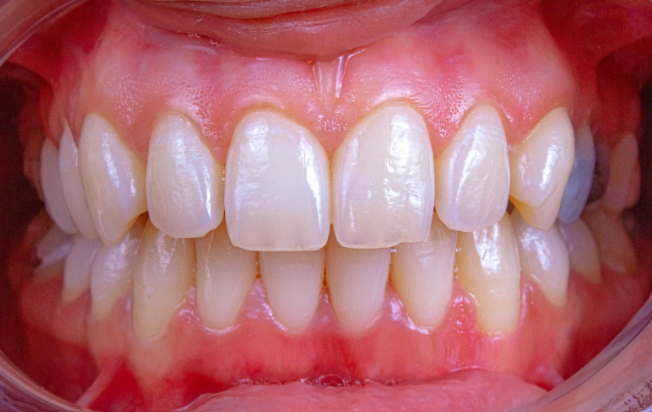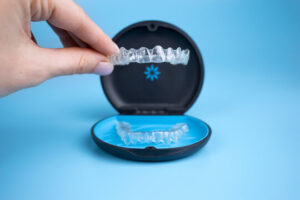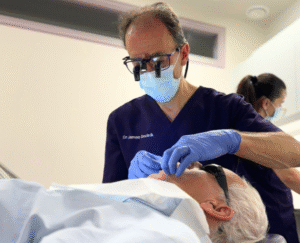Key Signs of Gum Disease: How to Recognise Symptoms
Gum disease, also known as periodontal disease, is one of the most common yet most preventable dental conditions in the UK, affecting a significant portion of the adult population. At Optimal Dental Health in London, we believe that understanding your oral health empowers you to protect it. It affects the tissues and bone that support your teeth, and recognising its early signs can make all the difference between simple treatment and permanent damage.
Many people overlook the subtle early signs, such as occasional bleeding when brushing or a slight puffiness along the gums, until discomfort or tooth movement makes the problem impossible to ignore. The truth is that gum disease often develops quietly. This guide will help you recognise the symptoms early, understand their causes, and know when to seek professional help so that you can keep your smile healthy for life.
Understanding Gum Disease
Gum disease begins when bacteria in dental plaque, an invisible sticky film that constantly forms on teeth, trigger inflammation in the gum tissues. When the gums become inflamed but the supporting bone remains intact, this stage is called gingivitis. Gingivitis is mild and reversible with good home care and professional cleaning.
If gingivitis is left untreated, inflammation can spread deeper, damaging the bone and ligaments that hold teeth in place. This advanced form is known as periodontitis. Periodontitis can lead to gum recession, loose teeth, and eventually tooth loss if not managed promptly.
Recognising the difference between early and advanced gum disease helps you take timely action and avoid invasive treatment later.
Early Signs of Gum Disease
The early stage is your body’s way of signalling that something isn’t quite right. At this point, gums are reacting to plaque buildup but the bone underneath is still healthy. You may notice some or all of the following:
- Bleeding Gums: Gums that bleed when you brush, floss, or eat hard foods are one of the earliest signs of inflammation. Occasional bleeding after brushing too hard can be harmless, but regular bleeding, even with gentle cleaning, suggests early gum disease.
- Red, Swollen, or Tender Gums: Healthy gums are firm and pale pink. When they appear red, puffy, or sore, it’s a clear sign of irritation caused by bacteria along the gumline.
- Persistent Bad Breath or a Bad Taste: Chronic bad breath (halitosis) or a lingering unpleasant taste can signal bacterial buildup in areas the toothbrush can’t reach.
Symptom | How It Appears | What It Means |
|---|---|---|
| Bleeding gums | Bleeding during brushing or flossing. Blood in sink after cleaning mouth, | Gingival inflammation due to plaque; needs professional cleaning |
| Red/swollen gums | Puffy, tender tissue | Early gingivitis from bacterial irritation |
| Bad breath/taste | Constant unpleasant odour | Bacterial overgrowth or trapped food particles |
Why Do Gums Bleed?
Bleeding occurs because inflamed gum tissue becomes rich in blood vessels that rupture easily. When plaque accumulates at the gumline, your immune system reacts, sending more blood and immune cells to the area. This makes gums fragile and prone to bleeding when touched.
If you notice bleeding regularly for more than a week despite gentle brushing, it’s time for a professional examination, a key recommendation from the British Dental Association (BDA) for early intervention. At Optimal Dental Health, we can assess whether it’s simple gingivitis or the start of something more serious and provide a tailored cleaning and care plan to stop the inflammation before it spreads.
Red, Swollen, and Tender Gums: What They Reveal
Gums that look red and swollen are showing visible signs of inflammation. The tissue becomes softer and more fluid-filled as your immune system tries to fight off bacterial plaque. This swelling may make brushing uncomfortable, but avoiding cleaning only allows more bacteria to thrive.
Using a soft-bristled toothbrush, gentle circular brushing motions, and daily interdental cleaning can help reduce irritation while removing plaque effectively. In many cases, these simple steps combined with professional cleaning can reverse gingivitis entirely within weeks.
Advanced Symptoms: When Gum Disease Becomes Periodontitis
If early gum inflammation is not addressed, bacteria and hardened deposits called calculus begin to extend below the gumline. This causes the tissues that hold your teeth in place to detach, forming “pockets” that trap even more bacteria. The result is periodontitis, a chronic infection that gradually damages bone and connective tissue.
You may notice:
- Receding Gums: Teeth appear longer as gum tissue pulls away from the tooth. This exposes sensitive root surfaces and can make your teeth look uneven.
- Loose or Shifting Teeth: As bone support decreases, teeth can move slightly or feel wobbly when you chew.
- Pus or Painful Chewing: These are signs of active infection and require immediate professional attention.
Sign | Underlying Cause | Urgency/Action |
|---|---|---|
| Receding gums | Tissue and bone loss | Schedule a periodontal evaluation |
| Loose teeth | Breakdown of bone support | Seek urgent care to stabilise |
| Pus or pain | Infection in periodontal pocket | Immediate treatment required |
Advanced gum disease cannot be reversed at home, but timely professional therapy can stop its progression and, in some cases, regenerate lost tissue.

Why Do Gums Recede?
Gum recession occurs when the soft tissue attachment around a tooth moves downward (on upper teeth) or upward (on lower teeth), exposing the root. This happens as a result of chronic inflammation and loss of the supporting bone underneath. Patients often notice that teeth appear “longer,” or they may feel sensitivity to cold and sweet foods.
Recession is a sign of structural change rather than temporary inflammation. Early intervention, such as scaling and root planing or regenerative procedures, can slow or even reverse its course, preserving both comfort and appearance.

Loose Teeth and Bite Changes
When you begin to feel your teeth move slightly or your bite no longer feels natural, it means the bone and ligament that anchor your teeth have weakened. This can make chewing painful or uneven and may lead to shifting teeth or gaps.
Our specialists at Optimal Dental Health assess tooth mobility and use digital imaging to measure bone support. With proper periodontal therapy, we can often stabilise these teeth and prevent further movement.
Pus and Painful Chewing
The presence of pus along the gumline or between teeth signals a periodontal abscess, a pocket of infection caused by trapped bacteria. Pain when chewing, swelling, or fever may accompany it. This is a dental emergency requiring immediate treatment to prevent spread to deeper tissues. Prompt drainage, cleaning, and sometimes antibiotics are needed to control the infection and protect your health.
What Causes Gum Disease and Who Is at Risk?
The leading cause of gum disease is dental plaque, but several factors increase susceptibility:
| Risk Factor | How It Contributes |
|---|---|
| Poor oral hygiene | Plaque buildup and bacterial growth |
| Smoking | Reduces blood flow and healing capacity |
| Diabetes | Impairs immune function and tissue repair |
| Hormonal changes | Increases gum sensitivity and inflammation |
| Certain medications | Can cause a dry oral cavity or gum overgrowth |
| Genetic predisposition | Some individuals are naturally more susceptible |
Plaque that isn’t removed daily hardens into tartar, which firmly attaches to teeth and can only be removed by a dental professional. This mineralised surface shelters harmful bacteria, allowing inflammation to persist.
Gum Disease and Whole-Body Health
Research, supported by leading UK health bodies like the Oral Health Foundation, has shown strong links between chronic gum disease and systemic health conditions, including heart disease, stroke, diabetes complications, respiratory infections, and adverse pregnancy outcomes. The same inflammation that affects the gums can influence the body’s immune and vascular systems.
By maintaining healthy gums, you’re not only protecting your smile, you’re also contributing to your overall wellbeing.
Preventing Gum Disease: Daily Habits That Work
Prevention is the most effective treatment. Here’s what you can do to protect your gums every day:
- Brush Twice Daily – Use a soft-bristled brush and fluoride toothpaste, angling the bristles 45° to the gumline.
- Clean Between Teeth – Floss or use interdental brushes once a day to remove plaque between teeth.
- Use warm salty Mouthwash – can reduce inflammation and speed up healing.
- Avoid Tobacco – Smoking dramatically increases gum disease severity.
- Eat a Balanced Anti-inflammatory Diet – Vitamins C and D support gum health.
- Stay Consistent with Dental Visits – Regular professional cleanings remove tartar and catch problems early.
These steps, combined with professional monitoring, align with UK dental health guidelines and can prevent gum disease from developing or recurring.
Professional Treatments for Gum Disease
If gum disease has already developed, treatment options depend on how advanced it is. At Optimal Dental Health, we provide comprehensive periodontal care tailored to each patient’s needs.
1. Non-Surgical Therapy
- Scaling and Root Planing: Deep cleaning that removes tartar from below the gumline and smooths root surfaces to allow gums to reattach.
- Local Antimicrobials: Targeted medication placed into pockets to eliminate bacteria. We like using Ozonated water and gas.
We also offer ozone therapy in London, a safe and non-invasive treatment that uses ozone gas or ozonated water to help eliminate harmful bacteria and promote gum healing. This holistic therapy can enhance the effectiveness of traditional treatments like scaling and root planing, supporting faster recovery and healthier gums.
2. Surgical Therapy
When deep pockets or bone loss persist, surgical options may be required:
- Flap Surgery: Lifts gum tissue to remove deep deposits and reduce pocket depth.
- Bone Grafting and Regenerative Procedures: Stimulate bone and tissue regrowth to stabilise teeth.
| Treatment | Purpose | Recovery |
|---|---|---|
| Scaling & Root Planing | Remove deep deposits | Mild tenderness for 1–2 days |
| Local Antibiotics | Reduce infection | Minimal discomfort |
| Flap Surgery | Access deep pockets | Moderate healing time |
| Bone Grafting | Regenerate support | Several weeks of healing |
Regardless of the stage, treatment always aims to eliminate infection, stop progression, and maintain function. With regular maintenance, most patients achieve stable, healthy gums and can retain their natural teeth for decades.
When to Seek Professional Help
If you notice any of the following, schedule a dental evaluation as soon as possible:
- Gums that bleed regularly or appear swollen
- Persistent bad breath despite brushing
- Teeth that feel loose or have shifted position
- Receding gums or visible root surfaces
- Pain, pus, or swelling around a tooth
Severe swelling, fever, or difficulty swallowing requires emergency care.
Early diagnosis is the key to success. Gingivitis can often be completely reversed with professional cleaning and improved home care, while periodontitis can be stabilised with advanced therapy when caught early.
A Healthier Future for Your Smile
Gum disease may be common, but it doesn’t have to be inevitable. With daily care, regular check-ups, and professional guidance, you can protect your gums, preserve your natural teeth, and enhance your long-term health. At Optimal Dental Health, Baker Street, our approach is simple: prevention, precision, and personalised care. You deserve a confident, healthy smile, and we’re here to help you achieve that through evidence-based, holistic dentistry.
About the Author

Dr James Goolnik is the founder of Optimal Dental Health in London and an award-winning dentist with extensive expertise in restorative and preventive dentistry. A past President of the British Academy of Cosmetic Dentistry (a leading UK professional body), Dr Goolnik is internationally recognised for promoting minimally invasive, health-centred dental care. His approach focuses on empowering patients with knowledge, combining cutting-edge science with a personalised, caring touch to help every patient achieve lasting oral health and confidence.



